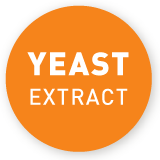Naturally occurring glutamic acid has a savoury and “rich” taste. It is often present in foods that are rich in proteins, which are therefore rich in amino acids. Ripe tomatoes, meat, Parmesan cheese and legumes contain a lot of glutamic acid, as well as popular condiments such as soy sauce, tomato ketchup and yeast extract. Yeast extract is a popular spread in the UK and Australia, and food producers also use it to add a savoury taste to their products and dishes. Despite its savoury taste of its own, which is comparable to meat broth, yeast extract is a purely vegetarian ingredient which is also suitable for vegan diets.
While the presence of glutamic acid is an important indicator to mammals and humans that a foodstuff is rich in protein, it is also one of the amino acids that is produced by the human body itself, and controls vital functions. For example, it is one of the most important activating neurotransmitters within the central nervous system. Neurotransmitters are substances that pass on information or stimuli from one nerve cell to the other via the synapse. Furthermore, it is also involved in the formation of other amino acids, binds to the cellular toxin ammonia so that it may be transported to the kidneys, and also improves concentration and learning capabilities. As a building block for proteins, which makes up our muscles, heart, brain, skin and hair, the body produces its own glutamic acid.



